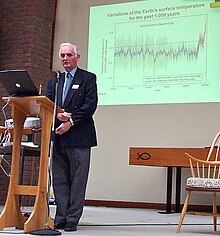
The IPCC Third Assessment Report (TAR), Climate Change 2001, is an assessment of available scientific and socio-economic information on climate change by the IPCC. Statements of the IPCC or information from the TAR were often used as a reference showing a scientific consensus on the subject of global warming. The Third Assessment Report (TAR) was completed in 2001 and consists of four reports, three of them from its Working Groups: Working Group I: The Scientific Basis;[1] Working Group II: Impacts, Adaptation and Vulnerability;[2] Working Group III: Mitigation;[3] Synthesis Report.[4] A number of the TAR's conclusions are given quantitative estimates of how probable it is that they are correct, e.g., greater than 66% probability of being correct.[5] These are "Bayesian" probabilities, which are based on an expert assessment of all the available evidence.[6][7]
"Robust findings" of the Synthesis Report include:
- "Observations show Earth's surface is warming. Globally, 1990s very likely warmest decade in instrumental record".[8] Atmospheric concentrations of anthropogenic (i.e., human-emitted) greenhouse gases have increased substantially.[8]
- Since the mid-20th century, most of the observed warming is "likely" (greater than 66% probability, based on expert judgement)[5] due to human activities.[8]
- Projections based on the Special Report on Emissions Scenarios suggest warming over the 21st century at a more rapid rate than that experienced for at least the last 10,000 years.[8]
- "Projected climate change will have beneficial and adverse effects on both environmental and socioeconomic systems, but the larger the changes and the rate of change in climate, the more the adverse effects predominate."[8]
- "Ecosystems and species are vulnerable to climate change and other stresses (as illustrated by observed impacts of recent regional temperature changes) and some will be irreversibly damaged or lost."[8]
- "Greenhouse gas emission reduction (mitigation) actions would lessen the pressures on natural and human systems from climate change."[8]
- "Adaptation [to the effects of climate change] has the potential to reduce adverse effects of climate change and can often produce immediate ancillary benefits, but will not prevent all damages."[8] An example of adaptation to climate change is building levees in response to sea level rise.[9]
- ^ TAR Working Group 1 Archived 2021-12-28 at the Wayback Machine, IPCC.
- ^ TAR Working Group 2 Archived 2016-05-14 at the Wayback Machine, IPCC.
- ^ TAR Working Group 3 Archived 2017-02-27 at the Wayback Machine, IPCC.
- ^ TAR Synthesis Report Archived 2021-08-14 at the Wayback Machine, IPCC.
- ^ a b "Question 2" (PDF), Box 2-1: Confidence and likelihood statements, archived (PDF) from the original on 28 July 2021, retrieved 12 August 2021, in IPCC TAR SYR 2001 Q2 p 44
- ^ Ahmad, Q.K.; et al., "Ch 2: Methods and Tools" (PDF), Sec. 2.6.2. "Objective" and "Subjective" Probabilities are not Always Explicitly Distinguished, archived (PDF) from the original on 8 August 2021, retrieved 12 August 2021, in IPCC TAR WG2 2001 Ch 2 p 129
- ^ Granger Morgan, M.; et al. (2009), Synthesis and Assessment Product 5.2: Best practice approaches for characterizing, communicating, and incorporating scientific uncertainty in decisionmaking. A Report by the U.S. Climate Change Science Program (CCSP) and the Subcommittee on Global Change Research (PDF), Washington D.C.: National Oceanic and Atmospheric Administration, archived from the original (PDF) on 16 June 2013, pp. 19–20, 27–28. Report website. Archived 11 December 2009 at the Wayback Machine
- ^ a b c d e f g h Synthesis Report of the IPCC Third Assessment Report: Summary for Policymakers. Cambridge University Press. 2001. ISBN 0-521-80770-0. Archived from the original on 14 August 2021. Retrieved 12 August 2021.
- ^ Nicholls, R.J.; et al., "Ch 6: Coastal Systems and Low-Lying Areas" (PDF), Table 6.11, archived (PDF) from the original on 8 August 2021, retrieved 12 August 2021, in IPCC AR4 WG2 2007 Ch 6-1 p 343}}